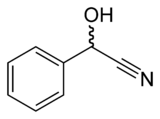Mandelonitrile
 | |
-Mandelonitrile-3D-balls.png) | |
| Names | |
|---|---|
| IUPAC name
2-Hydroxy-2-phenylacetonitrile | |
| Other names
α-Hydroxybenzeneacetonitrile | |
| Identifiers | |
| 3D model (JSmol) |
|
| ChEBI | |
| ChemSpider | |
| ECHA InfoCard | 100.007.758 |
| KEGG | |
| PubChem CID |
|
| |
| |
| Properties | |
| C8H7NO | |
| Molar mass | 133.15 g·mol−1 |
| Density | 1.117 g/mL |
| Melting point | −10 °C (14 °F; 263 K) (R/S)[2] |
| Boiling point | 170 °C (338 °F; 443 K) Decomposes[2] |
| Hazards | |
| Main hazards | toxic |
| R-phrases (outdated) | R23/24/25 R36/37/38 R41 |
| S-phrases (outdated) | S22 S26 S36/37/39 S45 |
| Flash point | 113 °C (235 °F; 386 K) |
| Related compounds | |
| Related compounds |
mandelic acid, phenylacetonitrile |
| Except where otherwise noted, data are given for materials in their standard state (at 25 °C [77 °F], 100 kPa). | |
| | |
| Infobox references | |
In organic chemistry, mandelonitrile is the cyanohydrin derivative of benzaldehyde. Small amounts of mandelonitrile occur in the pits of some fruits.
Occurrence
Mandelonitrile is the aglycone part of the cyanogenic glycosides prunasin and amygdalin.
The naturally occurring (R)-(+) enantiomer finds use as an intermediate in the preparation of optically active α-hydroxy carboxylic acids, α-hydroxy aldehydes, α-hydroxy ketones, and 2-amino alcohols.[3]
Mandelonitrile can break down into cyanide and benzaldehyde, a reaction that can be catalyzed by the enzyme mandelonitrile lyase.
Preparation
Racemic mandelonitrile may be prepared similar to many other cyanohydrins. In a one pot reaction, benzaldehyde is reacted with sodium bisulfite to give the corresponding adduct, which further reacts with aqueous sodium cyanide to give the racemic product:[4]
References
- ↑ Sigma-Aldrich product page
- 1 2 The Merck Index (12th ed.). 1996.
- ↑ Kruse, C.G. In Collins, A.N. Sheldrake, G.N. Crosby, J., Eds. Chirality in Industry Chichester, UK , (1992), 279
- ↑ Corson, B. B.; Dodge, R. A.; Harris, S. A.; Yeaw, J. S. (1941). "Mandelic Acid". Org. Synth.; Coll. Vol., 1, p. 336
